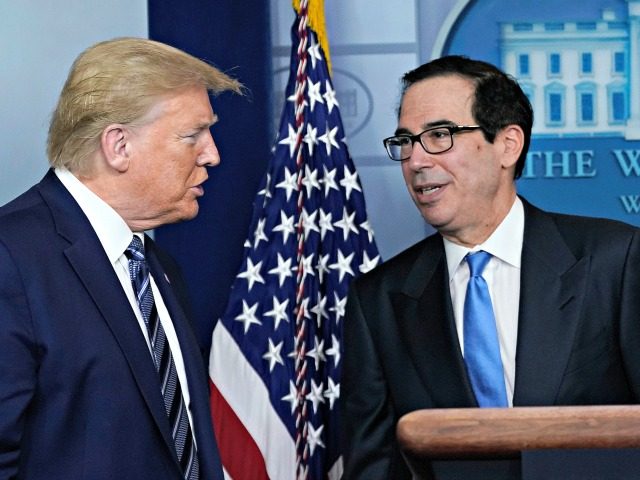The Trump administration’s signature relief program for small businesses came under relentless assault and media-manufactured outrage this week after the Treasury Department released the names of the top borrowers under the Paycheck Protection Program.
The program provides government-backed bank loans to small businesses. Some or all of the loan amount is forgivable if borrowers use at least 60 percent of the funds for payroll. The goal was to keep workers attached to their jobs even though coronavirus shutdowns had shuttered many businesses or crushed demand to virtually zero for many lines of work. It was also set up to encourage businesses to quickly staff up as the economy reopened.
It appears to be working, although it is still early and the data on jobs saved is sparse. But the economy stopped shedding jobs in May and employers hired a record number of workers. That kept up in June. There are still a huge number of layoffs each week but the number has come way down since the program was implemented (although, admitedly, progress here has stalled in recent weeks).
The Trump administration initially sought to protect the identity of borrowers under the program, fearing that releasing the information could create a stigma and discourage participation. That could cause layoffs to rise as employers hunkered down, cut payrolls, and refused to borrow for fear of being publicly castigated or investigated for borrowing.
But Trump critics in the media and the Democrat party refused to be placated, insisting that the administration disclose data on the borrowers and the loans. And so the Trump administration decided to comply and released the names of 650,000 borrowers who had tapped the program for $150,000 or more.
The media immediately went into naming and shaming mode, ignoring the job-preservation purpose of the program and attacking supposedly unsympathetic or undeserving borrowers.
“Billionaires, country clubs, private jet companies and Kanye West all received millions in government funding under the Paycheck Protection Program,” CNBC reported.
That’s not quite true. Companies owned by billionaires received loans rather than the billionaires themselves. But those loans will have to be repaid with interest unless they are used to support employee wages. Is the argument that the locker room guys at the closed-down country club should be laid off?
Stephanie Ruhle of MSNBC complained about a hedge fund receiving loans after Bloomberg published an article about it.
Again…
I just want an explanation. How does a hedge fund manager explain taking the money.
Management fees were in tact.Fallen Hedge Fund’s Head Among Money Managers Getting PPP Relief https://t.co/Z0xK4HUJwq
— Stephanie Ruhle (@SRuhle) July 7, 2020
But hedge funds employ lots of people, including receptionists and office managers, whose jobs would have likely been eliminated if not for loans to support paying them even though the shutdowns had rendered them superfluous. You do not need someone to greet guests and clients in the lobby when no one visits and the offices are empty. Ordinarily, people whose functions have been eliminated are considered “redundant” and laid off—regardless of whether their employer could afford to pay them.
The same applies to law firms and many of the other businesses that came under attack for taking out loans. The point of the Paycheck Protection Program was not to evaluate which businesses did or did not deserve support. That kind of economic-planning, picking winners and losers, was intentionally avoided. Instead the point was to get employers to act as a conduit to support the incomes of their workers.
Economist Claudia Sahm, whose namesake Sahm Rule is winning wide acceptance as the new marker for when the government should step in with direct aid to households in an economic downturn, has been a big advocate of government intervention for workers and households when the economy slumps. She criticized the media’s coverage of the borrowers in a tweet.
agree 100%!! me yesterday: https://t.co/Ff7M5lfG9I
— Claudia Sahm (@Claudia_Sahm) July 7, 2020
The Associated Press breathlessly reported that “as much as $273 million in federal coronavirus aid was awarded to more than 100 companies that are owned or operated by major donors to President Donald Trump’s election efforts.” To put that in perspective, that is around 0.05 percent of the total $511 billion of loans that were made under the program. A nickle for every hundred bucks. Not even a rounding error and certainly not a sign of political favoritism.
All of this media misdirection could produce the very consequences the Trump administration initially feared disclosure would bring about. If the economy falters again—say from a second wave of the pandemic—borrowers may shy away from aid that will set them under the microscope of media attention and cancel culture. Easier just to let the workers go and try to hire them back when the economy approves. That would work fine for many firms but would be an economic disaster.
Initially, there was some logic to the stories about bigger business or well-connected firms getting loans. The first swathe of money approved by Congress quickly ran out, creating a zero-sum situation where each firm that got money was denying others funding. But Congress swiftly appropriated an additional $310 billion, bringing the total size of the PPP to $659 billion. And since just $511 billion has been drawn, no company’s loan is depriving any other business of funding.
That should have put an end to the outrage. It has not, in part because the media love declaring Trump administration programs a failure and in part because it is all too easy in the age of cancel culture to attack socially approved targets like Trump donors and hedge fund managers. And, unfortunately, the outrage puts us at risk of greater economic harm in the next downturn.

COMMENTS
Please let us know if you're having issues with commenting.